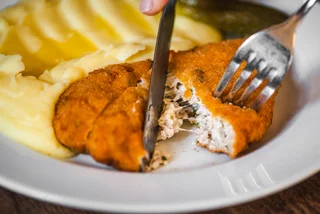Fried cheese (smažený sýr, or smažák) is a dish that stirs up a multitude of emotions in Czechia, at once a source of national pride and a guilty pleasure that's hard to resist.
While commonly associated with Czech cuisine, the origins of fried cheese actually lie beyond Czechia. We spoke to culinary experts from Lokál about how they've elevated the humble meat-free meal to a gourmet experience and how to make the perfect smažák at home with a few simple tips.
From schnitzel substitute to staple of Czech cuisine
Fried cheese likely originated in northern Italy and gradually spread to the Austro-Hungarian Empire. By the end of the 19th century, impoverished Viennese families commonly substituted a triple-coated piece of cheese for wiener schnitzel. Eventually, the dish made its way to the Czech lands where it was featured in Maria Haškovcová's First Republic cookbook at the start of the 20th century under the name "cheese schnitzel."
The renowned restaurant of the Grandhotel Šroubek (now Grand Hotel Evropa) was responsible for furthering the dish's popularity, with figures such as actor Vlasta Burian and former Czechoslovak President Tomáš Garrigue Masaryk enjoying smažený sýr as a luxurious indulgence rather than the pub fare it is today.

Fried cheese got its reputation as a mass-market, meatless dish during the communist era of the 1960s. The boom of ready-made meals and factory catering aimed to free women from the kitchen and lengthy meal preparations, encouraging them to engage in employment and nation-building.
The aftermath of the communists' PR campaign meant fried cheese fell out of favor with the people. Depoliticizing the dish took time, but it survived on menus as one of the few vegetarian options for diners today.
Lokál takes its fried cheese seriously
The next chapter in the history of fried cheese began with the opening of the first Lokál restaurant in 2009, which made it its mission to transform this humble dish into a menu star. The Lokál version features quality cheese that has been aged for several weeks wrapped in three layers of breading and fried to perfection in clarified butter, served with a side of buttered potatoes and tartar sauce made with homemade mayonnaise.

Ambiente chefs spent a year on the hunt for the best cheese, testing different recipes in collaboration with Czech Farma Struhy. Chefs and farmers studied the ripening process of cheese to achieve the ideal consistency to achieve a cheese that is tailor-made for Lokál.
-Lokál chef Libor BaďuraBefore the cheese makes it to the plate, several weeks pass. After the basic mixing of the mixture and pressing, the cheese goes into a salt bath, where it spends 48 hours. Subsequently, the cheeses are stored for 4-5 weeks. It's this longer aging process that sets it apart from traditional Eidam cheeses.
Currently, visitors who order fried cheese at selected Lokál restaurants – Dlouhá, Nad Stromovkou, U Jiráta, and U Bílé kuželky – will be able to try new artisan cheese that is being trialed alongside the existing selection. Feedback from patrons is encouraged!
Today almost 400 pieces of smažák are eaten here every day. The dish is the most frequently ordered item on the menu, and is regularly taste-tested for softness and stretching ability.
How to make fried cheese at home
Ingredients
- Quality edam (in Czech eidam) cheese, approximately 1 cm thick
- 2 eggs, lightly beaten
- 43 g semi-coarse flour
- 120 g breadcrumbs (from white bread)
- Oil for frying
Method
- 1.Coat cheese slices in layers of flour, eggs, and breadcrumbs. Quantities will vary depending on how many slices of cheese you are using.
- 2.Dredge the cheese first in semi-coarse flour (polohrubá) as smooth flour (hladká) is too fine and will stick.
- 3.Next, submerge the cheese into gently beaten eggs (do not salt the eggs).
- 4.Before dredging the cheese in the breading, make sure to shake off any lingering egg. Only then should you place it in the breadcrumb mixture.
- 5.Coat the cheese from all sides with the crumbs, but don't press down. This prevents cracked edges and leaking during frying.
- 6.Heat the oil in the pan, turn it down to medium when ready to fry, and fry coated cheese on both sides, each about 3-4 minutes until golden-brown.
Fried cheese around the world
References to cheese fried in batter can be found in Le Ménagier de Paris, a French medieval guide for virtuous housewives from 1393. The Swiss tradition of enjoying melted cheeses such as raclette or in fondue, goes back to at least 1291. The Swiss eventually succumbed to the appeal of the crispy crust. Balls of fried cheese, known as malakoff, were served as an appetizer at regal banquets, including one hosted by Napoleon's brother Jérôme Bonaparte.
Under the name cașcaval pane, you'll also find fried cheese in Romania and Bulgaria. It's a common dish in Brazil and the Dominican Republic, and in Costa Rica, Cyprus, and Greece, where it's even served for breakfast. In Turkey and Arab countries, however, look for it among desserts. Künefe is cheese wrapped in thin noodles, fried, and soaked in sweet sugar syrup.
In the Czech Kitchen is a weekly column written in cooperation with the culinary experts from Ambiente. Established in 1995, the Prague-based collective of pubs, restaurants, and fine-dining outlets has transformed the Czech culinary landscape and lent to the widespread awareness of quality food service and production in Czechia. Follow their socials or book your table at www.ambi.cz.












 Reading time: 4 minutes
Reading time: 4 minutes 

















